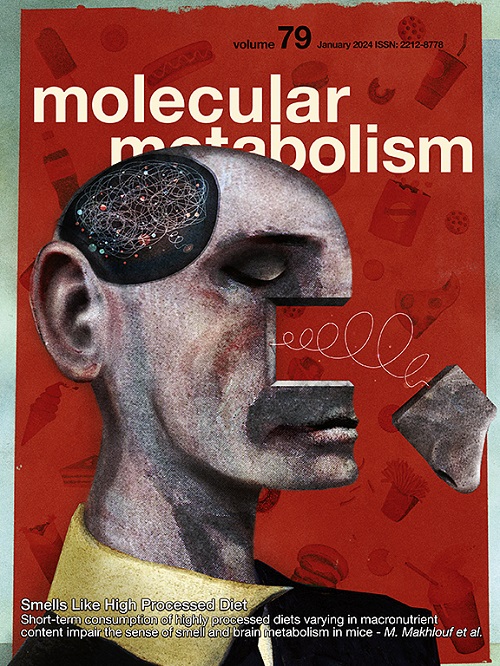Methylglyoxal-induced RNA modifications decrease RNA stability and translation and are associated with type 2 diabetes
IF 6.6
2区 医学
Q1 ENDOCRINOLOGY & METABOLISM
引用次数: 0
Abstract
Objectives
Methylglyoxal (MG), a reactive aldehyde generated as a byproduct of glucose and lipid metabolism, is known to modify nucleic acids and proteins, altering their structure and function. While MG-induced DNA and protein adducts have been extensively studied and associated with type 2 diabetes (T2D) and its complications, the formation, biological relevance, and functional consequences of MG-induced RNA adducts remain poorly understood. This study aimed to define the chemical structures of MG-derived RNA adducts, assess their presence in clinical samples, and determine their impact on RNA stability and translation.
Methods
We employed liquid chromatography-tandem mass spectrometry (LC-MS/MS), nuclear magnetic resonance (NMR), and other spectroscopic techniques to characterize MG-induced RNA adducts formed in vitro and in biological samples. RNA was isolated from cultured cells and clinical urine specimens from individuals with and without T2D. RNA stability and translation were assessed using firefly luciferase reporter mRNAs modified with MG in cell-based assays.
Results
In vitro MG treatment resulted in the formation of an unstable product, tentatively identified as N2-(1,2-dihydroxy-2-methyl)ethano-guanosine (cMG-guanosine), and two stable adducts: N2-(1-carboxyethyl)-guanosine (CEG) and N2-(1-carboxyethyl)-7–1-hydroxy-2-oxopropyl-guanosine (MG-CEG). In cellular RNA and urine from patients, only the stereoisomers of CEG were detected. CEG levels were significantly elevated in patients with T2D compared to controls and showed a stronger association with T2D than the DNA adduct N2-(1-carboxyethyl)-deoxyguanosine (CEdG). Furthermore, CEG levels were higher in T2D patients who had developed complications compared to those without complications. Functionally, MG-modified luciferase mRNA exhibited decreased stability and reduced translational efficiency relative to unmodified mRNA.
Conclusions
This study provides the first structural and functional characterization of MG-induced RNA adducts and demonstrates their accumulation in individuals with T2D, particularly in those with disease complications. These findings highlight RNA MG-adducts as clinically relevant epitranscriptomic modifications that may contribute to RNA destabilization and impaired translation, suggesting a novel molecular mechanism by which metabolic stress may exacerbate disease progression.
甲基乙二醛诱导的RNA修饰降低了RNA的稳定性和翻译,并与2型糖尿病有关。
甲基乙二醛(Methylglyoxal, MG)是代谢过程的副产物,可以修饰核酸和蛋白质,影响它们的结构和功能。DNA和蛋白质上的mg加合物已被很好地表征,并与2型糖尿病(T2D)及其相关并发症有关。然而,尽管RNA损伤作为细胞过程的重要标记和调节剂出现,mg诱导的RNA加合物的化学性质、它们与疾病的关联以及它们对RNA稳定性和翻译的影响尚不清楚。为了表征mg诱导的RNA损伤的化学性质,我们采用了分析和光谱技术。我们在体外观察到一个不稳定的产物,被认为是N2-(1,2-二羟基-2-甲基)乙醇-鸟苷(cmg -鸟苷)和两个稳定的加合物:N2-(1-羧乙基)-鸟苷(CEG)和N2-(1-羧乙基)-7-1-羟基-2-氧丙基鸟苷(MG-CEG)。虽然这些加合物在体外形成,但在细胞RNA和临床尿液样本中只观察到CEG的两种立体异构体。我们发现CEG在T2D患者中显著升高,与MG-DNA加合物N2-(1-羧乙基)-脱氧鸟苷(CEdG)相比,CEG与T2D的相关性更显著。我们还发现,与没有出现并发症的T2D患者相比,出现并发症的患者CEG显著升高,而非CEdG。MG修饰的萤火虫荧光素酶mRNA不稳定,翻译效率低于未修饰的mRNA。我们首次描述了mg诱导的特异性RNA加合物,它们与T2D患者疾病的相关性,以及它们对mRNA调控的影响,证明了RNA mg加合物是一种重要的、临床相关的表转录组修饰。
本文章由计算机程序翻译,如有差异,请以英文原文为准。
求助全文
约1分钟内获得全文
求助全文
来源期刊

Molecular Metabolism
ENDOCRINOLOGY & METABOLISM-
CiteScore
14.50
自引率
2.50%
发文量
219
审稿时长
43 days
期刊介绍:
Molecular Metabolism is a leading journal dedicated to sharing groundbreaking discoveries in the field of energy homeostasis and the underlying factors of metabolic disorders. These disorders include obesity, diabetes, cardiovascular disease, and cancer. Our journal focuses on publishing research driven by hypotheses and conducted to the highest standards, aiming to provide a mechanistic understanding of energy homeostasis-related behavior, physiology, and dysfunction.
We promote interdisciplinary science, covering a broad range of approaches from molecules to humans throughout the lifespan. Our goal is to contribute to transformative research in metabolism, which has the potential to revolutionize the field. By enabling progress in the prognosis, prevention, and ultimately the cure of metabolic disorders and their long-term complications, our journal seeks to better the future of health and well-being.
 求助内容:
求助内容: 应助结果提醒方式:
应助结果提醒方式:


